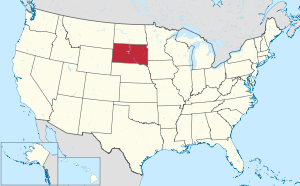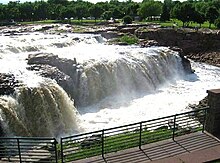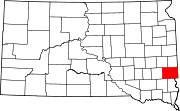Minnehaha County, South Dakota
Minnehaha County | |
|---|---|
 Minnehaha County Courthouse in Sioux Falls | |
 Location within the U.S. state of South Dakota | |
 South Dakota's location within the U.S. | |
| Coordinates: 43°41′N 96°47′W / 43.68°N 96.79°W | |
| Country | |
| State | |
| Founded | 1862 (created) 1868 (organized) |
| Named for | "rapid water" |
| Seat | Sioux Falls |
| Largest city | Sioux Falls |
| Area | |
• Total | 814 sq mi (2,110 km2) |
| • Land | 807 sq mi (2,090 km2) |
| • Water | 6.7 sq mi (17 km2) 0.8% |
| Population (2020) | |
• Total | 197,214 |
• Estimate (2023) | 206,930 |
| • Density | 239/sq mi (92/km2) |
| Time zone | UTC−6 (Central) |
| • Summer (DST) | UTC−5 (CDT) |
| Congressional district | At-large |
| Website | www |
Minnehaha County is a county on the eastern border of the state of South Dakota. As of the 2020 census, the population was 197,214,[1] making it the state's most populous county. It contains over 20% of the state's population. Its county seat is Sioux Falls,[2] South Dakota's most populous city. The county was created in 1862 and organized in 1868.[3] Its name was derived from the Sioux word Mnihaha, meaning "rapid water," or "waterfall" (often incorrectly translated as "laughing water").[4]
Minnehaha County is part of the Sioux Falls Metropolitan Statistical Area, the state's largest.
Geography


Minnehaha County lies on the east side of South Dakota. Its eastern boundary abuts Minnesota as well as the northern and western boundaries of Iowa. The Big Sioux River flows south-southeast through the east central part of the county. Its terrain consists of rolling hills, devoted to agriculture except around built-up areas, and dotted with lakes and ponds in its western portion.[5] Its terrain generally slopes southward, and the east and west edges slope to the river valley through the center of the county. Its highest point is in the northwest corner, at 1,752 ft (534 m) ASL.[6]
Minnehaha County has an area of 814 square miles (2,110 km2), of which 807 square miles (2,090 km2) is land and 6.7 square miles (17 km2) (0.8%) is water.[7]
Major highways
Transit
Airports
- Sioux Falls Regional Airport (FSD)
- Wheelborg Landing Field, a small airport in Dell Rapids
Adjacent counties
- Moody County - north
- Pipestone County, Minnesota - northeast
- Rock County, Minnesota - east
- Lyon County, Iowa - southeast
- Lincoln County - south
- Turner County - southwest
- McCook County - west
- Lake County - northwest
Protected areas
- Beaver Creek State Recreation Area
- Big Sioux State Recreation Area
- Diamond Lake State Game Production Area
- Falls Park
- Island Lake State Game Production Area (part)
- Palisades State Park
- Pederson State Game Production Area
- Scott Lake State Game Production Area
- Twin Lakes State Game Production Area
- Wall Lake State Lakeside Use Area
Lakes, rivers and streams[5]
- Beaver Creek
- Beaver Lake
- Big Sioux River
- Buffalo Lake
- Clear Lake
- Covell Lake
- Diamond Lake
- Fenstrman Slough
- Grass Lake
- Island Lake (partial)
- Lake Lorane
- Loss Lake
- Lost Lake
- Rehfeldt Slough
- Scott Lake
- Skunk Creek
- Split Rock Creek
- Twin Lake
- Wall Lake
Demographics
| Census | Pop. | Note | %± |
|---|---|---|---|
| 1870 | 355 | — | |
| 1880 | 8,251 | 2,224.2% | |
| 1890 | 21,879 | 165.2% | |
| 1900 | 23,926 | 9.4% | |
| 1910 | 29,631 | 23.8% | |
| 1920 | 42,490 | 43.4% | |
| 1930 | 50,872 | 19.7% | |
| 1940 | 57,697 | 13.4% | |
| 1950 | 70,910 | 22.9% | |
| 1960 | 86,575 | 22.1% | |
| 1970 | 95,209 | 10.0% | |
| 1980 | 109,435 | 14.9% | |
| 1990 | 123,809 | 13.1% | |
| 2000 | 148,281 | 19.8% | |
| 2010 | 169,468 | 14.3% | |
| 2020 | 197,214 | 16.4% | |
| 2023 (est.) | 206,930 | [8] | 4.9% |
| U.S. Decennial Census[9] 1790-1960[10] 1900-1990[11] 1990-2000[12] 2010-2020[1] | |||
2020 census
As of the 2020 census, there were 197,214 people, 78,715 households, and 48,690 families residing in the county.[13] The population density was 244.4 inhabitants per square mile (94.4/km2). There were 83,717 housing units.
2010 census
As of the 2010 census, there were 169,468 people, 67,028 households, and 42,052 families in the county. The population density was 210.0 inhabitants per square mile (81.1/km2). There were 71,557 housing units at an average density of 88.7 per square mile (34.2/km2). The racial makeup of the county was 88.1% white, 3.8% Black or African American, 2.5% American Indian, 1.5% Asian, 0.1% Pacific islander, 1.8% from other races, and 2.3% from two or more races. Those of Hispanic or Latino origin made up 4.1% of the population. In terms of ancestry, 43.8% were German, 17.7% were Norwegian, 11.6% were Irish, 6.8% were Dutch, 6.3% were English, and 3.2% were American.
Of the 67,028 households, 32.7% had children under the age of 18 living with them, 47.7% were married couples living together, 10.5% had a female householder with no husband present, 37.3% were non-families, and 29.3% of all households were made up of individuals. The average household size was 2.43 and the average family size was 3.03. The median age was 34.5 years.
The median income for a household in the county was $51,799 and the median income for a family was $64,645. Males had a median income of $40,187 versus $31,517 for females. The per capita income for the county was $26,392. About 6.9% of families and 9.7% of the population were below the poverty line, including 12.2% of those under age 18 and 7.6% of those age 65 or over.
Politics
Minnehaha is somewhat conservative for an urban county. Only four Democratic presidential candidates in five different elections have carried the county since 1940, and in only two of those elections the Democrat obtained a majority of the county's vote.
In the South Dakota Legislature, Sioux Falls falls into Districts 9-15, with each district electing two Representatives and one Senator. Only two out of seven districts (10th and 15th) are represented by Democrats.
| Year | Republican | Democratic | Third party(ies) | |||
|---|---|---|---|---|---|---|
| No. | % | No. | % | No. | % | |
| 2024 | 51,842 | 55.16% | 39,923 | 42.48% | 2,221 | 2.36% |
| 2020 | 49,249 | 53.34% | 40,482 | 43.85% | 2,595 | 2.81% |
| 2016 | 42,043 | 53.72% | 30,610 | 39.11% | 5,610 | 7.17% |
| 2012 | 40,342 | 52.68% | 34,674 | 45.28% | 1,567 | 2.05% |
| 2008 | 39,251 | 48.73% | 39,838 | 49.46% | 1,463 | 1.82% |
| 2004 | 44,189 | 56.92% | 32,314 | 41.62% | 1,129 | 1.45% |
| 2000 | 33,428 | 54.47% | 27,042 | 44.06% | 899 | 1.46% |
| 1996 | 27,432 | 44.24% | 29,790 | 48.05% | 4,782 | 7.71% |
| 1992 | 25,081 | 39.32% | 27,016 | 42.35% | 11,689 | 18.33% |
| 1988 | 26,765 | 47.71% | 29,135 | 51.94% | 195 | 0.35% |
| 1984 | 29,908 | 56.25% | 23,042 | 43.34% | 221 | 0.42% |
| 1980 | 26,256 | 51.00% | 20,008 | 38.87% | 5,214 | 10.13% |
| 1976 | 23,286 | 51.12% | 22,068 | 48.44% | 202 | 0.44% |
| 1972 | 22,447 | 49.90% | 22,386 | 49.76% | 155 | 0.34% |
| 1968 | 20,141 | 53.31% | 16,462 | 43.57% | 1,177 | 3.12% |
| 1964 | 16,766 | 44.48% | 20,929 | 55.52% | 0 | 0.00% |
| 1960 | 23,238 | 60.53% | 15,152 | 39.47% | 0 | 0.00% |
| 1956 | 22,285 | 62.99% | 13,093 | 37.01% | 0 | 0.00% |
| 1952 | 23,559 | 71.50% | 9,390 | 28.50% | 0 | 0.00% |
| 1948 | 14,047 | 53.77% | 11,770 | 45.05% | 308 | 1.18% |
| 1944 | 13,920 | 57.67% | 10,216 | 42.33% | 0 | 0.00% |
| 1940 | 16,664 | 57.62% | 12,259 | 42.38% | 0 | 0.00% |
| 1936 | 12,418 | 46.85% | 13,174 | 49.70% | 916 | 3.46% |
| 1932 | 10,288 | 44.21% | 12,646 | 54.34% | 339 | 1.46% |
| 1928 | 13,741 | 66.68% | 6,805 | 33.02% | 62 | 0.30% |
| 1924 | 8,822 | 55.93% | 1,524 | 9.66% | 5,427 | 34.41% |
| 1920 | 8,290 | 63.15% | 2,534 | 19.30% | 2,303 | 17.54% |
| 1916 | 4,318 | 52.64% | 3,494 | 42.59% | 391 | 4.77% |
| 1912 | 0 | 0.00% | 2,576 | 42.38% | 3,502 | 57.62% |
| 1908 | 4,125 | 64.07% | 1,948 | 30.26% | 365 | 5.67% |
| 1904 | 4,455 | 74.04% | 1,046 | 17.38% | 516 | 8.58% |
| 1900 | 3,410 | 57.04% | 2,440 | 40.82% | 128 | 2.14% |
| 1896 | 2,429 | 47.20% | 2,667 | 51.83% | 50 | 0.97% |
| 1892 | 2,208 | 52.31% | 484 | 11.47% | 1,529 | 36.22% |
Communities
Cities
- Baltic
- Brandon
- Colton
- Crooks
- Dell Rapids
- Garretson
- Hartford
- Sioux Falls (county seat)
- Valley Springs
Towns
Census-designated places
Unincorporated communities[5]
Townships
- Benton
- Brandon
- Buffalo
- Burk
- Clear Lake
- Dell Rapids
- Edison
- Grand Meadow
- Hartford
- Highland
- Humboldt
- Logan
- Lyons
- Mapleton
- Palisade
- Red Rock
- Sioux Falls
- Split Rock
- Sverdrup
- Taopi
- Valley Springs
- Wall Lake
- Wayne
- Wellington
Historical townsites

- East Sioux Falls
- Eminija
- South Sioux Falls
- West Sioux Falls
- Wingert
Education
School districts in the county include:[15]
- Baltic School District 49-1
- Brandon Valley School District 49-2
- Canton School District 41-1
- Chester School District 39-1
- Dell Rapids School District 49-3
- Garretson School District 49-4
- Harrisburg School District 41-2
- Lennox School District 41-4
- Montrose School District 43-2
- Parker School District 60-4
- Sioux Falls School District 49-5
- Tea Area School District 41-5
- Tri-Valley School District 49-6
- West Central School District 49-7
Various rural schools operated in the county's history.[16]
See also
References
- ^ a b "State & County QuickFacts". United States Census Bureau. Retrieved March 21, 2024.
- ^ "Find a County". National Association of Counties. Retrieved June 7, 2011.
- ^ "Dakota Territory, South Dakota, and North Dakota: Individual County Chronologies". Dakota Territory Atlas of Historical County Boundaries. The Newberry Library. 2006. Archived from the original on April 2, 2018. Retrieved March 30, 2015.
- ^ Stewart, George R. (1945). Names on the Land. Random House. p. 291.
In the language of the Sioux, a waterfall was haha; water itself was minne. White men by a misunderstanding had coupled the two words, and produced Minnehaha Falls, a name thus meaning "water-waterfalls-falls". By a complete though natural misunderstanding of haha, the name had been romantically translated as Laughing Water
- ^ a b c "Minnehaha County · South Dakota".
- ^ ""Find an Alittude" Google Maps (accessed February 7, 2019)". Archived from the original on May 21, 2019. Retrieved February 8, 2019.
- ^ "2010 Census Gazetteer Files". United States Census Bureau. August 22, 2012. Retrieved March 28, 2015.
- ^ "County Population Totals and Components of Change: 2020-2023". Retrieved March 17, 2024.
- ^ "U.S. Decennial Census". United States Census Bureau. Retrieved March 28, 2015.
- ^ "Historical Census Browser". University of Virginia Library. Retrieved March 28, 2015.
- ^ Forstall, Richard L., ed. (March 27, 1995). "Population of Counties by Decennial Census: 1900 to 1990". United States Census Bureau. Retrieved March 28, 2015.
- ^ "Census 2000 PHC-T-4. Ranking Tables for Counties: 1990 and 2000" (PDF). United States Census Bureau. April 2, 2001. Archived (PDF) from the original on October 9, 2022. Retrieved March 28, 2015.
- ^ "US Census Bureau, Table P16: Household Type". United States Census Bureau. Retrieved March 21, 2024.
- ^ Leip, David. "Atlas of US Presidential Elections". uselectionatlas.org. Retrieved April 15, 2018.
- ^ "2020 CENSUS - SCHOOL DISTRICT REFERENCE MAP: Minnehaha County, SD" (PDF). U.S. Census Bureau. Retrieved July 29, 2023. - Text list
- ^ "Minnehaha County Country Rural Schools" (PDF). State of South Dakota. Retrieved July 29, 2023.

